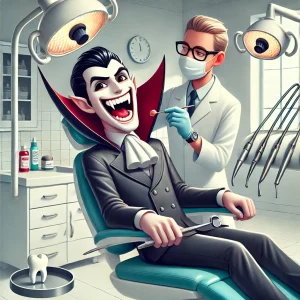Vampires and Fangs: A Timeless Tale

For centuries, vampires have been a captivating part of Western mythology, evolving from the shadowy towers of Transylvania to the glamorous figures we see on today’s TV screens. But how did vampires become so iconic, and where did their famous fangs come from? Let’s dive into the fascinating world of vampire lore and explore the evolution of their sharp, menacing fangs.
Where Did Vampires Originate?
Vampires weren’t always the sleek and mysterious figures we now recognize. In fact, their origins are far less refined. Early descriptions of vampires painted them as bloated, decaying corpses with foul breath and rotten teeth—far from the charming predators we know today. It wasn’t until the 19th century, with Bram Stoker’s Dracula (1897), that fangs became a defining characteristic of vampires. Stoker’s depiction of Count Dracula revolutionized the image of vampires, transforming them from grotesque ghouls into suave figures. This shift in portrayal forever altered the way we envision vampires—and their teeth.
The Role of Fangs
Fangs, or elongated canine teeth, serve an important role in the natural world, and vampires were no exception in folklore. Canines are designed for gripping and tearing food, a trait shared by all mammals. Interestingly, humans also have four canines, which begin growing at around 16 months of age. These teeth are not only functional but also tend to be more resistant to plaque build-up due to their smaller surface area. Additionally, canines are often the last teeth to fall out, making them an enduring feature—just like vampire fangs in folklore.

Old Hollywood Bites Back
The evolution of vampires didn’t stop with literature. By the 1950s and 60s, Hollywood brought vampires—and their fangs—into the cinematic spotlight. Thanks to Hammer Horror Films, vampires became even more entrenched in popular culture. Actors like Christopher Lee, with his portrayal of Dracula, terrified audiences with his short, stubby fangs, making them a hallmark of the genre. Later on, films like The Lost Boys and Interview With a Vampire introduced even more dramatic, elongated fangs, further cementing their place in vampire mythology.
Dentistry for Vampires: A Practical Matter
As the myth of vampires continued to evolve, so too did the idea that even these supernatural creatures would need proper dental care. After all, plaque build-up doesn’t discriminate, even among immortals. Without proper care, fangs—just like human teeth—can suffer from decay, caries, and gum disease. Even Dracula himself would need regular dental check-ups to keep his infamous bite in perfect condition.
In today’s world, dental advancements allow for custom-made fangs, whether for Halloween costumes or cosmetic purposes. At Dentaprime, we’ve even had patients ask about getting fangs, though we always advise against it for safety reasons.
Zirconia: The Choice for Eternal Teeth

While vampires may be fictional, their need for strong, durable teeth mirrors real-world desires. In modern dentistry, zirconia—a highly
durable material often used for dental implants—offers an excellent solution for those seeking strong, long-lasting teeth. Unlike natural enamel, zirconia doesn’t degrade, making it an ideal choice for both humans and, perhaps, supernatural beings like vampires.
A Timeless Bite
From their humble, bloated beginnings to their refined, high-fashion fangs, vampires have evolved into a symbol of both horror and allure. Whether you prefer the terrifying counts lurking in gothic castles or the more modern, glittering vampires from Twilight, one thing is certain: vampires and their iconic fangs are here to stay, forever a part of our cultural imagination.


